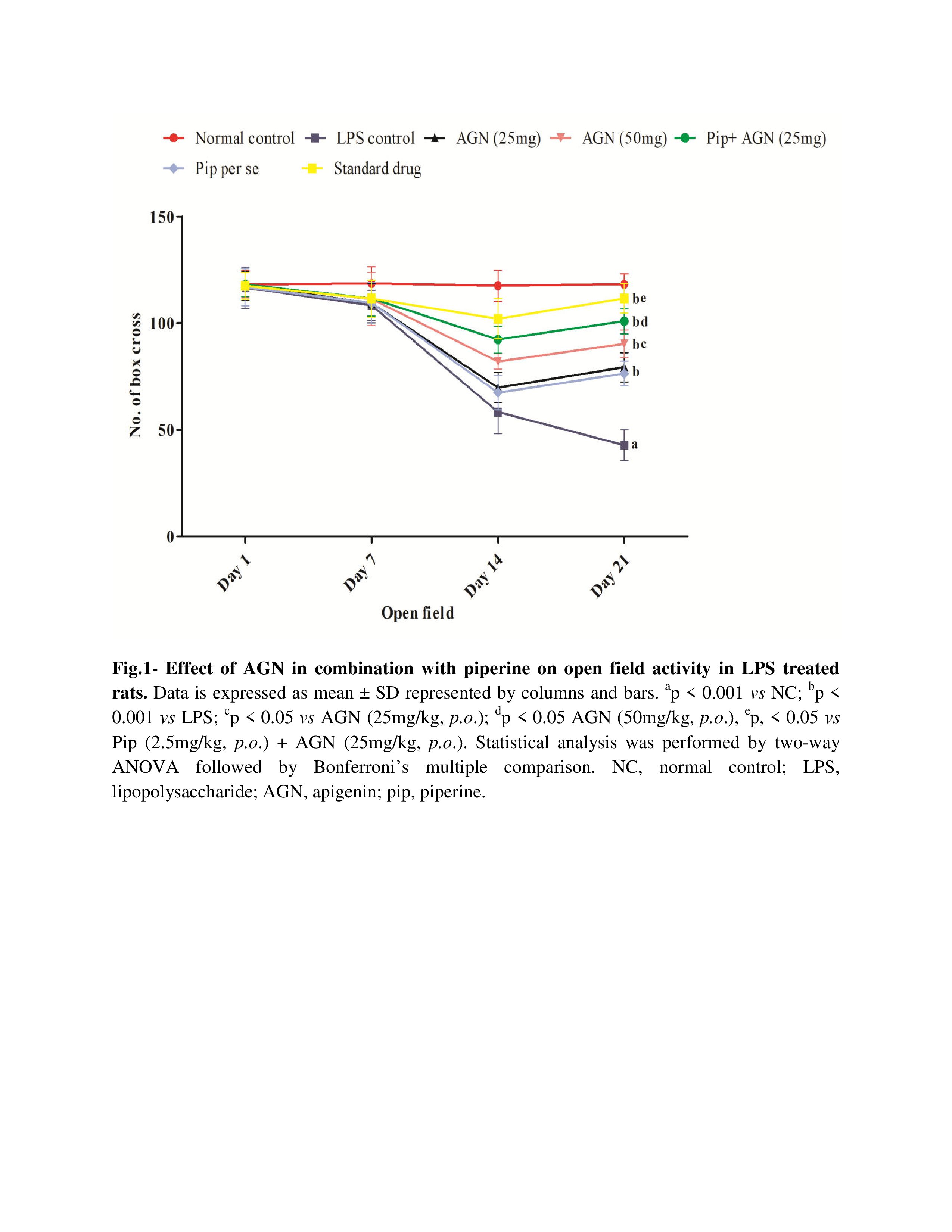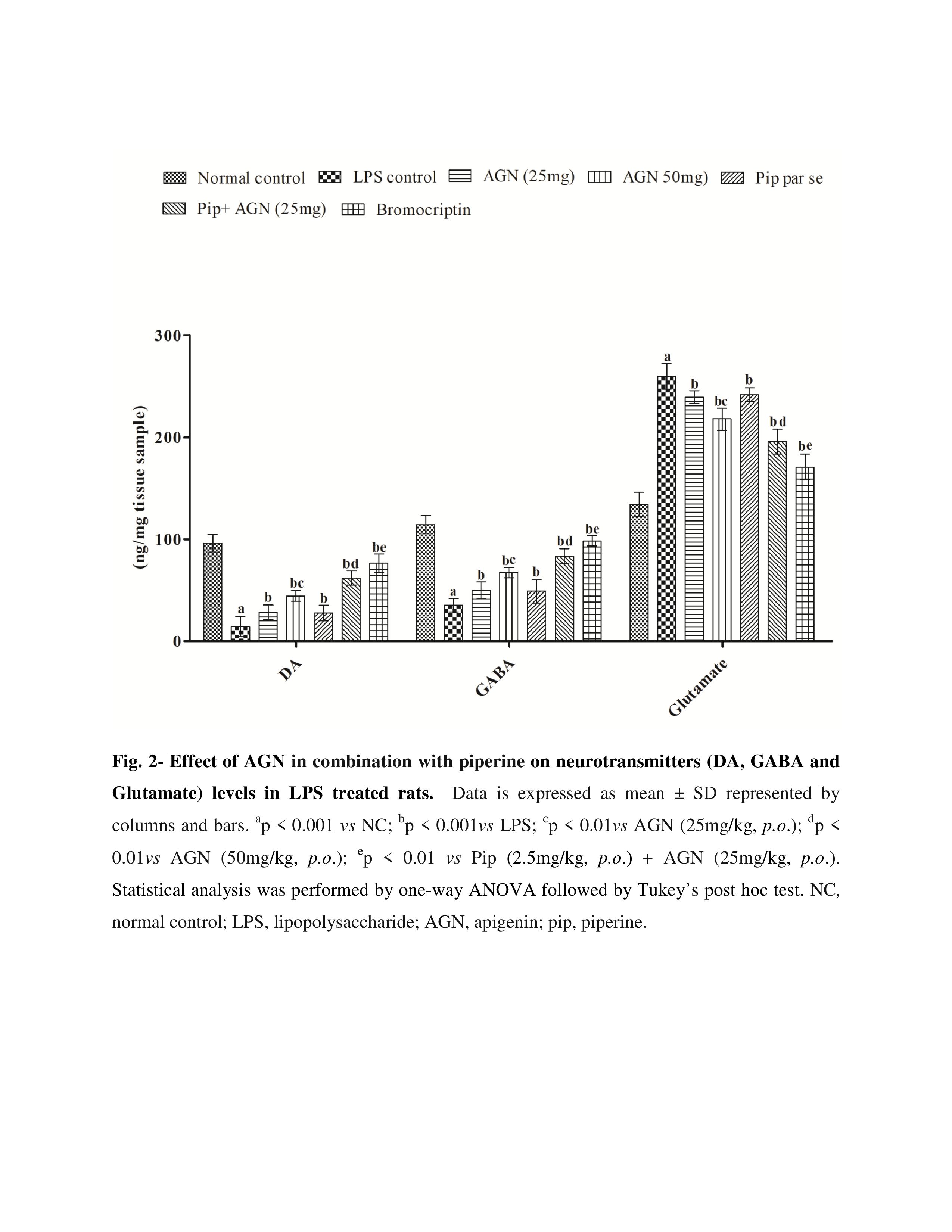Objective: 1. Apigenin as a protective strategy to prevent neuroinflammation in PD.
2. To find behavioral, neurochemical and histopathological changes in LPS induced PD.
Background: Parkinson’s disease (PD) is a progressive hypokinetic movement disorder and a leading cause of disability around the world caused by selective degeneration of dopaminergic neurons in the striatum, a region of the midbrain. LPS induced neurotoxicity involves a cascade of events such as microglial activation, neuroinflammation, oxidative stress and neurotransmitters alteration. Therefore, we investigated apigenin (AGN), a natural flavonoid having free radical scavenging, anti-inflammatory and neuroprotective properties.
Method: In this study, rats were treated with a single unilateral intranigral injection of LPS at a dose of 5μg/5μl on day 0. The oral administration of AGN (25, 50mg/kg; p.o.) alone, Piperine (2.5mg/kg; p.o.), AGN (25mg/kg; p.o.) in combination with piperine (2.5mg/kg; p.o.) and bromocriptine (10mg/kg; p.o.) started from day 7thonce in a day. Alteration in body weight and behavioral parameters were assessed on day 1st, 7th, 14th and 21st. After a behavioral assessment on day 22nd all animals were sacrificed and brain tissue was isolated for biochemical (nitrite, MDA, SOD, CAT, GSH and complex-I), neuroinflammatory (TNF-α, IL-1β, IL-6, NF-kB, Nrf2 and Caspase-1), neurotransmitters (DA, GABA and Glutamate), histopathological and immunohistochemistry (NF-kB and Nrf2) analysis.
Results: It was found that upon LPS injection significantly altered body weight, locomotor activity, motor coordination, neurotransmitters levels. Treatment with AGN (25mg/kg; p.o.) in combination with piperine (2.5mg/kg; p.o.) significantly attenuated the alteration in body weight, motor impairments, oxidative stress, neuroinflammation and neurotransmitters in rat brain. Further, AGN exhibited neuroprotection and significantly prevented alteration in LPS alteration in NF-kB and Nrf2 signaling pathway in striatum.
Conclusion: The apigenin provided neuroprotective effect via antioxidant, anti-inflammatory, neuromodulatory mechanisms and attenuation of NF-kB and Nrf2 signaling.
References: 1. Flores-Martinez YM, Fern andez-Parrilla MA, Ayala-Davila J, Reyes-Corona D, Blanco-Alvarez VM, Soto-Rojas LO, Luna-Herrera C, Gonzalez-Barrios JA, Leon-Chavez BA, Gutierrez-Castillo ME, Martínez-Dávila IA (2018) Acute neuroinflammatory response in the substantia nigra pars compacta of rats after a local injection of lipopolysaccharide. Journal of immunology research, 2018. https://doi.org/10.1155/2018/1838921.
2. Loboda A, Damulewicz M, Pyza E, Jozkowicz A, Dulak J (2016) Role of Nrf2/HO-1 system in development, oxidative stress response and diseases: an evolutionarily conserved mechanism. Cellular and molecular life sciences 73:3221-3247. https://doi.org/10.1007/s00018-016-2223-0.
To cite this abstract in AMA style:
S. Singh. Protective approach targeting NF-kB/ Nrf2 signaling and neuroinflammation using Apigenin in LPS induced Parkinsonism in experimental rats [abstract]. Mov Disord. 2022; 37 (suppl 2). https://www.mdsabstracts.org/abstract/protective-approach-targeting-nf-kb-nrf2-signaling-and-neuroinflammation-using-apigenin-in-lps-induced-parkinsonism-in-experimental-rats/. Accessed April 18, 2025.« Back to 2022 International Congress
MDS Abstracts - https://www.mdsabstracts.org/abstract/protective-approach-targeting-nf-kb-nrf2-signaling-and-neuroinflammation-using-apigenin-in-lps-induced-parkinsonism-in-experimental-rats/


